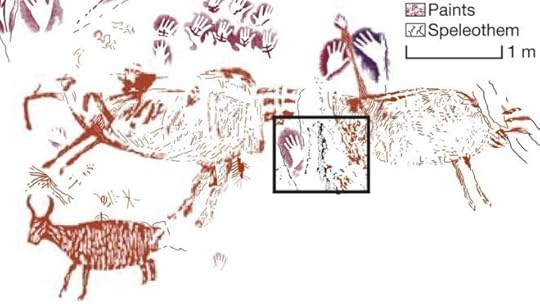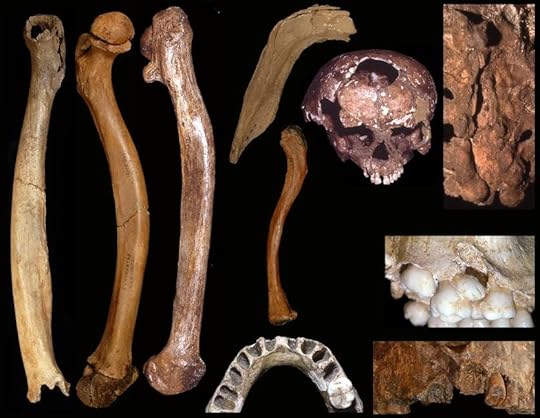Michael J. Behe's Blog, page 572
November 8, 2018
Materialist Reaches New Low
Barry: Can we know with absolute certainty that it is evil to torture a baby for pleasure?
JDK: “There is no possible answer to the question: it’s a meaningless question.”
UPDATE:
JDK has accused me of being intellectually dishonest for quoting him as saying (1) there is no possible answer to the question; and (2) it is a meaningless question. He has implied that the “context” of his statement makes it mean something other than what it appears to mean on its face.
OK JDK. I’ll bite. Do you believe the question has meaning and it is possible to answer? If so, answer it. If not, apologize for saying the quotation was dishonest.
SECOND UPDATE:
JDK continues to post in the comment thread. I noted that he had posted twice without responding. His response:
A true fact, Barry. This makes three times.
It surprises no one, I am sure, that JDK’s charge of dishonesty was, itself, fundamentally dishonest. What should we expect from someone who claims to be wobbly on the whole baby torture issue?
Copyright © 2018 Uncommon Descent . This Feed is for personal non-commercial use only. If you are not reading this material in your news aggregator, the site you are looking at is guilty of copyright infringement UNLESS EXPLICIT PERMISSION OTHERWISE HAS BEEN GIVEN. Please contact legal@uncommondescent.com so we can take legal action immediately.
Plugin by Taragana
Materialist Perhaps Reaches New Low
Barry: Can we know with absolute certainty that it is evil to torture a baby for pleasure?
JDK: “There is no possible answer to the question: it’s a meaningless question.”
Copyright © 2018 Uncommon Descent . This Feed is for personal non-commercial use only. If you are not reading this material in your news aggregator, the site you are looking at is guilty of copyright infringement UNLESS EXPLICIT PERMISSION OTHERWISE HAS BEEN GIVEN. Please contact legal@uncommondescent.com so we can take legal action immediately.
Plugin by Taragana
Cockatoos can learn to adjust tools
Goffin cockatoo/Goffin Lab, UVMVienna (CC-BY)
From ScienceDaily:
Captive Goffins are capable of inventing and manipulating tools, even though they aren’t known to use tools habitually. The authors of the present study investigated two questions: do Goffins adjust tool properties to save effort, and if so, how accurately can they adjust tool dimensions for the task? The authors supplied six adult cockatoos with large cardboard sheets to tear into strips as tools for the testing apparatus: a food platform with a food reward set at varying distances (4-16cm) behind a small opening which also varied in width (1-2cm).
They found that the Goffins were capable of adjusting the length of their cardboard strip tools to account for variations in food distance, making shorter tools when the reward was closer than when it was set farther away. In every case, if a first-attempt tool was too short, the second-attempt tool would be significantly longer. On average, all six birds made significantly longer tools than were required to reach the reward in all test conditions, with the birds tending to make increasingly long tools as the study progressed — perhaps as a risk-avoidance strategy.
However, only one bird was able to make a sufficiently-narrow tool to successfully reach the food reward when the opening was at its narrowest. The authors hypothesize that the shearing technique the birds use to tear the cardboard limits the narrowness of the resulting strips. The authors suggest that future studies provide less restrictive materials to assess whether Goffins are cognitively capable of adjusting tool width in this situation.
Alice Auersperg adds: “The way they inserted and discarded manufactured pieces of specific lengths differently depending on condition suggests that the cockatoos could indeed adjust their tool making behavior in the predicted direction but with some limits in accuracy. “Paper. (open access) – A. M. I. Auersperg, C. Köck, M. O’Hara, L. Huber. Tool making cockatoos adjust the lengths but not the widths of their tools to function. PLOS ONE, 2018; 13 (11): e0205429 DOI: 10.1371/journal.pone.0205429
More.
The interesting thing about this behaviour is that the cockatoos don’t use tools habitually in the wild. Does the bird’s intelligent behaviour increase in association with humans? If so, how, precisely, does that work?
Follow UD News at Twitter!
See also: Cockatoo cracks lock unassisted
Crows create compound tools
Do crows’ vending machine skills “redefine intelligence”?
Can smart crows tell us how new technology evolved?
and
Animal minds: In search of the minimal self
Copyright © 2018 Uncommon Descent . This Feed is for personal non-commercial use only. If you are not reading this material in your news aggregator, the site you are looking at is guilty of copyright infringement UNLESS EXPLICIT PERMISSION OTHERWISE HAS BEEN GIVEN. Please contact legal@uncommondescent.com so we can take legal action immediately.
Plugin by Taragana
World’s oldest known painting, 40,000 years old, found in Borneo jungle

Completed painting is bottom left; the square area was used for dating/Nature
A thick-bodied animal in red ocher:
Researchers have found older man-made images, but these were abstract patterns, such as crisscrossing lines. The switch to figurative art represented an important shift in how people thought about the world around them — and possibly themselves. Carl Zimmer, “In Cave in Borneo Jungle, Scientists Find Oldest Figurative Painting in the World” at New York Times
We actually don’t know that there aren’t older painting (or newer crisscrossed lines). This one was only just found.
The caves contain thousands of other images, including hand stencils, animals, abstract signs, and symbols:
The animal appears to have a spear shaft stuck in its flank and is one of a series of similar red-orange coloured paintings, which were made with iron-oxide pigment. Paul Rincon, “‘Oldest animal painting’ discovered in Borneo” at BBC
A paper published in Science earlier this year discusses cave art from 65,000 years ago, possibly made by Neanderthals:
Abstract
The extent and nature of symbolic behavior among Neandertals are obscure. Although evidence for Neandertal body ornamentation has been proposed, all cave painting has been attributed to modern humans. Here we present dating results for three sites in Spain that show that cave art emerged in Iberia substantially earlier than previously thought. Uranium-thorium (U-Th) dates on carbonate crusts overlying paintings provide minimum ages for a red linear motif in La Pasiega (Cantabria), a hand stencil in Maltravieso (Extremadura), and red-painted speleothems in Ardales (Andalucía). Collectively, these results show that cave art in Iberia is older than 64.8 thousand years (ka). This cave art is the earliest dated so far and predates, by at least 20 ka, the arrival of modern humans in Europe, which implies Neandertal authorship. More.
Follow UD News at Twitter!
See also: Human evolution: Ancient art not really symbolic, cognitive scientist claims
and
Copyright © 2018 Uncommon Descent . This Feed is for personal non-commercial use only. If you are not reading this material in your news aggregator, the site you are looking at is guilty of copyright infringement UNLESS EXPLICIT PERMISSION OTHERWISE HAS BEEN GIVEN. Please contact legal@uncommondescent.com so we can take legal action immediately.
Plugin by Taragana
Moths use “acoustic camouflage” to evade bats
Madagascar bullseye moth/Thomas Neil
Their fuzz works like an acoustic panel to cut down the noise volume from their movements. From ScienceDaily:
While some moths have evolved ears that detect the ultrasonic calls of bats, many types of moths remain deaf. In those moths, Neil has found that the insects developed types of “stealth coating” that serve as acoustic camouflage to evade hungry bats.
Neil will describe his work during the Acoustical Society of America’s 176th Meeting, held in conjunction with the Canadian Acoustical Association’s 2018 Acoustics Week, Nov. 5-9 at the Victoria Conference Centre in Victoria, Canada.
In his presentation, Neil will focus on how fur on a moth’s thorax and wing joints provide acoustic stealth by reducing the echoes of these body parts from bat calls.
“Thoracic fur provides substantial acoustic stealth at all ecologically relevant ultrasonic frequencies,” said Neil, a researcher at Bristol University. “The thorax fur of moths acts as a lightweight porous sound absorber, facilitating acoustic camouflage and offering a significant survival advantage against bats.” Removing the fur from the moth’s thorax increased its detection risk by as much as 38 percent.
…
In comparing the effects of removing thorax fur from insects that serve as food for bats to those that don’t, Neil’s research team found that thoracic fur determines acoustic camouflage of moths but not butterflies.
“We found that the fur on moths was both thicker and denser than that of the butterflies, and these parameters seem to be linked with the absorptive performance of their respective furs,” Neil said. “The thorax fur of the moths was able to absorb up to 85 percent of the impinging sound energy. The maximum absorption we found in butterflies was just 20 percent.”– Materials provided by Acoustical Society of America More.
Well, butterflies are usually active during the day, when bats scarce and noise is common.
Interesting how we take for granted that something can just “evolve” randomly by natural selection acting on random mutation, given enough time, but no one works it out. Probably because the probability is against it. Darwinism is a faith and not one that favors examination of the evidence.
Follow UD News at Twitter!
See also: “Confounding”: Moths and butterflies predate flowering plants by millions of years
and
Porchlight causes moths to evolve?
Copyright © 2018 Uncommon Descent . This Feed is for personal non-commercial use only. If you are not reading this material in your news aggregator, the site you are looking at is guilty of copyright infringement UNLESS EXPLICIT PERMISSION OTHERWISE HAS BEEN GIVEN. Please contact legal@uncommondescent.com so we can take legal action immediately.
Plugin by Taragana
Pleistocene human remains show many deformities

Some developmental abnormalities found in Pleistocene people/Eric Trinkaus
Apparently, the golden age in the distant past of good health due to clean, fresh outdoor living was a myth after all:
Anthropologist Erik Trinkaus from Washington University in St Louis, US, compiled examination records for two Late Pleistocene infants, six children, four juveniles, six adolescents, 30 prime age adults, and eight older adults, from several archaeological sites around the world.
He discovered that all up they showed evidence of 75 skeletal or dental abnormalities. Based on rates of similar disorders in modern human populations, Trinkaus finds the probability that the total is merely an artefact of comparatively small sample size to be “vanishingly small”.Andrew Masterson, “Huge numbers of deformities found in ancient human remains” at Cosmos
Trinkaus stresses that the surprise isn’t the evidence of deformities but the sheer number, plus the fact that many deformities are rare and one fifth “defy proper diagnosis.”
Maybe the sufferers left few descendants. Many of the disorders are rare today. But the problems may not have been heritable anyway; rather, life was tough in those times and far more people had big health problems. The “fittest,” in a Darwinian sense, may not even have been very fit.
Follow UD News at Twitter!
See also: Aging has always been with us, say researchers (to no one’s surprise)
Anomaly: Human mortality hits a plateau after 105 years of age
Is aging a disease or does it serve an evolutionary purpose?
and
Study: Religiously affiliated people lived “9.45 and 5.64 years longer…”
Copyright © 2018 Uncommon Descent . This Feed is for personal non-commercial use only. If you are not reading this material in your news aggregator, the site you are looking at is guilty of copyright infringement UNLESS EXPLICIT PERMISSION OTHERWISE HAS BEEN GIVEN. Please contact legal@uncommondescent.com so we can take legal action immediately.
Plugin by Taragana
November 7, 2018
Common coral species features unique immune strategy

Corals growing in UM Rosenstiel lab/Kevin Rodriguez
From ScienceDaily:
Roughly 30 percent of the cauliflower coral’s (Pocillopora damicornis) genome was unique compared to several other reef-building corals. In this 30%, many of these genes were related to immune function. This diversity of genes related to immune function, the researchers say, may be important for the long-term survival of coral reefs as climate change and ocean acidification continue to alter the environment to which corals are adapted.
“This coral is traditionally thought of as a weed, and yet it may be one of the last corals to survive environmental changes such as climate change,” said senior author of the study Nikki Traylor-Knowles, an assistant professor of marine biology and ecology at the UM Rosenstiel School.
An animal like the coral does not get to be a weed unless it has some remarkable abilities.
“The study shows that this is an important coral with a very complex and unique immune system, which may explain why it is able to survive in so many different locations,” said the paper’s lead author Ross Cunning, who conducted the research as a postdoctoral scientist at the UM Rosenstiel School and is now a researcher at Shedd Aquarium.
These results suggest that the evolution of an innate immune system has been a defining feature of the success of hard corals like P. damicornis, and may help facilitate their continued success under climate change scenarios. Paper. (open access) – R. Cunning, R. A. Bay, P. Gillette, A. C. Baker, N. Traylor-Knowles. Comparative analysis of the Pocillopora damicornis genome highlights role of immune system in coral evolution. Scientific Reports, 2018; 8 (1) DOI: 10.1038/s41598-018-34459-8 More.
But how does it just happen to evolve such different immune system? What is the probability of that happening by Darwinian means in the given period of time?
Follow UD News at Twitter!
See also: Corals alter their DNA to cope with acidity
and
Cretaceous living fossil coral found
Relax:
Copyright © 2018 Uncommon Descent . This Feed is for personal non-commercial use only. If you are not reading this material in your news aggregator, the site you are looking at is guilty of copyright infringement UNLESS EXPLICIT PERMISSION OTHERWISE HAS BEEN GIVEN. Please contact legal@uncommondescent.com so we can take legal action immediately.
Plugin by Taragana
No one evolved faster than the Neanderthal

Neanderthal/Photaro
Look how smart he got in the last few decades:
This from a discussion of whether Neanderthals had language:
Based on these results, most researchers agree Neanderthals were capable of emitting and hearing complex vocalizations. However, they disagree over the implications. While some consider the findings indicative of speech-based language in Neanderthals, others propose these features could have evolved for other reasons, like singing. Neanderthals may have lacked the cognitive abilities for language, but possessed the physical anatomy for musical calls to attract mates or sooth infants.
To assess if Neanderthals had the brains for language, researchers usually rely on proxies from the archaeological record — artifacts that required the same cognitive prerequisites as language, such as hierarchical organization or abstract symbolic thought. The latter is necessary to encode sounds with meanings and evidenced by artifacts like beads and cave paintings.
So did Neanderthals make those things? Eh, well, maybe. A few cases of Neanderthal ornaments and paintings have been reported, but are so rare that researchers question their authorship and antiquity. However, Neanderthals could have been symbolic in other ways. For instance, at many Neanderthal sites, archaeologists have found butchered wing bones from birds of prey. This could indicate Neanderthals adorned themselves with feathers (which did not preserve) imbued with symbolic meaning.Bridget Alex, “The Ongoing Debate Over Neanderthal Language” at Discover
We don’t have many Neanderthal remains to study though. Some of us remember when the first Neanderthal art was found and it was a bombshell.
Follow UD News at Twitter!
See also: Neanderthals did know how to start fires
Researchers: Neanderthals used fire to forge tools 170 kya
Was Neanderthal man fully human? The role racism played in assessing the evidence
Neanderthal Man: The long-lost relative turns up again, this time with documents
and
A deep and abiding need for Neanderthals to be stupid. Why?
Copyright © 2018 Uncommon Descent . This Feed is for personal non-commercial use only. If you are not reading this material in your news aggregator, the site you are looking at is guilty of copyright infringement UNLESS EXPLICIT PERMISSION OTHERWISE HAS BEEN GIVEN. Please contact legal@uncommondescent.com so we can take legal action immediately.
Plugin by Taragana
Requests for actual statistics FRAUD not unusual, science writer finds

What’s hot? What’s not?/Niklas Bildhauer, Wikimedia
There may be an additional, more sinister explanation for the ongoing reproducibility crisis, he suggests:
A stunning report published in the Annals of Internal Medicine concludes that researchers often make “inappropriate requests” to statisticians. And by “inappropriate,” the authors aren’t referring to accidental requests for incorrect statistical analyses; instead, they’re referring to requests for unscrupulous data manipulation or even fraud.
The authors surveyed 522 consulting biostatisticians and received sufficient responses from 390. Then, they constructed a table (shown below) that ranks requests by level of inappropriateness. For instance, at the very top is “falsify the statistical significance to support a desired result,” which is outright fraud. At the bottom is “do not show plot because it did not show as strong an effect as you had hoped,” which is only slightly naughty.Alex Berezow, “1 In 4 Statisticians Say They Were Asked To Commit Scientific Fraud” at American Council on Science and Health
In the midst of all this, there are people with the gall to be doing studies about why the public doesn’t trust science. Would it help if we pretended to be Darwinists and claimed that there is a survival advantage in not trusting science? Given that the field studied above was biostatistics, we could make a case…
Follow UD News at Twitter!
See also: Surprise: Science thrives when people can admit they didn’t prove something
and
What can a huge retractions database teach us? Overall, improved vigilance has slowed the trend, but key problems remain, including manipulated images. If a picture is worth a thousand words, that’s about three to five paragraphs of falsehood.
Copyright © 2018 Uncommon Descent . This Feed is for personal non-commercial use only. If you are not reading this material in your news aggregator, the site you are looking at is guilty of copyright infringement UNLESS EXPLICIT PERMISSION OTHERWISE HAS BEEN GIVEN. Please contact legal@uncommondescent.com so we can take legal action immediately.
Plugin by Taragana
November 6, 2018
Subjectivist Cowardice on Display
JDK wrote in a comment to my last post: “I just believe it is true that there is no Truth that we can know.”
I replied by stating that the fact that it is evil to torture a baby for pleasure is certainly true. And I challenged JDK: “Deny that. I dare you.”
JDK refused my dare and ran for cover.
JDK’s statement and my statement are mutually exclusive. They cannot be both be true. So it should be easy for JDK to deny my claim if he truly believes his claim. Yet he refuses to do so. Why? Because at bottom he is a coward. He comes into these pages and make bold claims about the unknowability of truth. And when confronted with the loathsome repugnance of his moral squalor, instead of standing by his claim, he tucks tail and runs.
Maybe I am wrong. I will give JDK another chance just to make sure. Here goes.
JDK, you say “there is no Truth that we can know.” I say we can know with absolute certainty that it is evil to torture a baby for pleasure. Go ahead, deny my claim. I dare you again.
Copyright © 2018 Uncommon Descent . This Feed is for personal non-commercial use only. If you are not reading this material in your news aggregator, the site you are looking at is guilty of copyright infringement UNLESS EXPLICIT PERMISSION OTHERWISE HAS BEEN GIVEN. Please contact legal@uncommondescent.com so we can take legal action immediately.
Plugin by Taragana
Michael J. Behe's Blog
- Michael J. Behe's profile
- 219 followers



